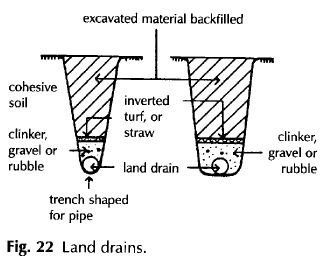Ground water (land) drains are laid in trenches at depths of 0.6 and 0.9 m in heavy soils and 0.9 to 1.2 m in light soils. The nominal bore of the pipes is usually 75 and 100 mm for main drains and 65 or 75 mm for branches.
The {drain} pipes are laid in the bed of the drain trench and surrounded with clinker, gravel or broken pervious rubble which is covered with inverted turf, brushwood or straw to separate the back fill from the pipes and their surround. Excavated material is backfilled into the drain trench up to the natural ground level.
The drain trench bottom may be shaped to take and contain the pipe or finished with a flat bed as illustrated in Fig. 22, depending on the nature of the subsoil and convenience in using a shaping tool.

Where drains are laid to collect mainly surface water the trenches are filled with clinker, gravel or broken rubble to drain water either to a drain or without a drain as illustrated in Fig. 23 in the form known as a French drain. Whichever is used will depend on the anticipated volume of water and the economy of dispensing with drainpipes.
